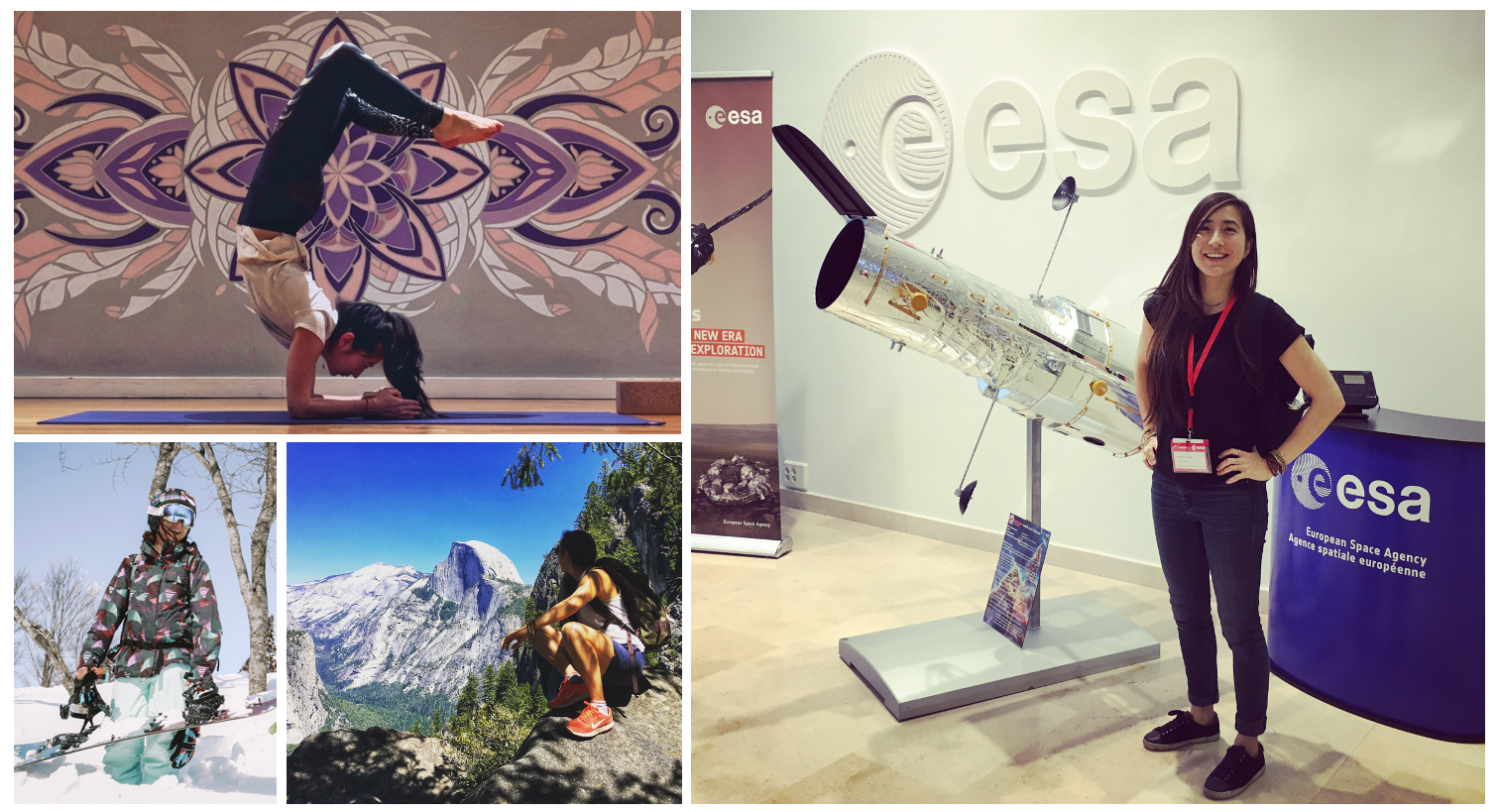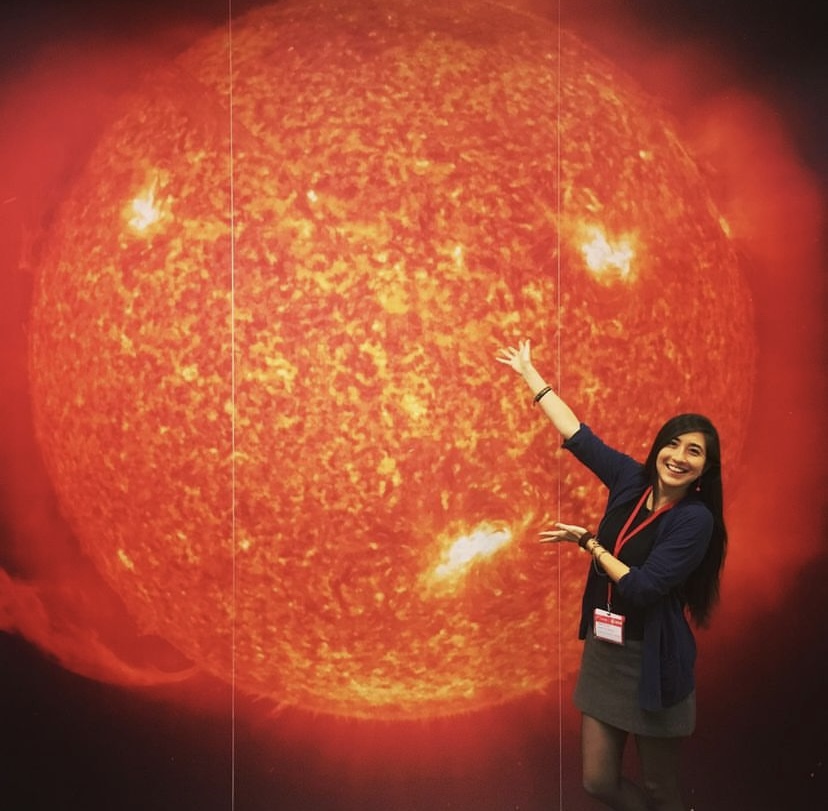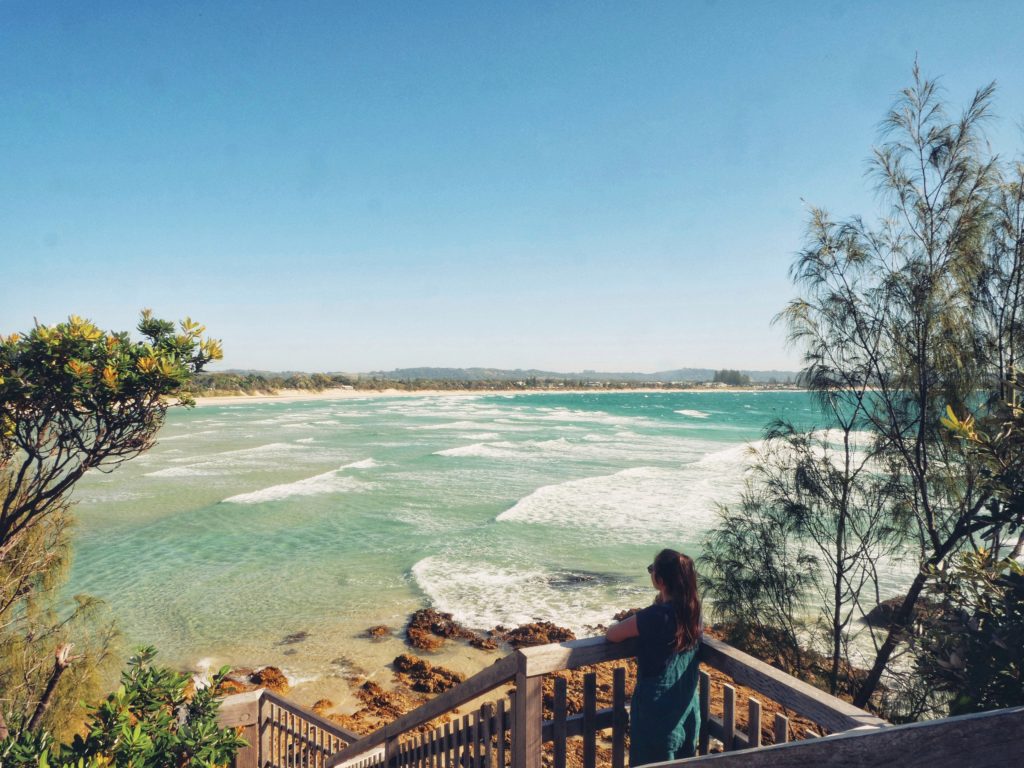
Chasing the Sun: Career story of Miho Janvier
Emilia Kilpua
Catching the waves in Byron Bay, trekking in the mountains of California, snowboarding in the Japanese Alps and mastering upside-down yoga poses that defy gravity. Miho Janvier seems to be all about insanely cool things. And on top of that she is a solar physicist who has followed her own path.
At 37 years Miho has become one of the central figures in the field. She works with Europe’s latest space asset Solar Orbiter, gives invited talks around the world, is a TED fellow, and has done exciting research on solar storms that can threaten our planet.
In recent years her life went in a whirlwind coping with the covid pandemic, becoming a mother, moving to new places and starting an exciting job at the European Space Agency.
I chatted with Miho to share her career story; how she became a scientist, why it is so great to study the Sun, how she balances between different aspects of life and has navigated through an academic world that is hard but what in the end she finds extremely rewarding.
A nomad child who loved aliens
Miho was born in Turkey to a French father and Japanese mother. Her father was posted every three years to a new place. From Turkey the family moved to Finland and from the snowy northern country to sunny and hot Senegal. Next stop was France before relocating to Japan during Miho’s teenage years.
Already as a child Miho loved discovering things and looking for reasons behind natural phenomena. Physics was not part of primary school teaching but she liked biology. Aliens and the question of life somewhere else in the universe fascinated the young girl’s curious mind. She watched Spielberg’s E.T and was a big X-files fan.
The childhood passion evolved into an interest in exobiology and astrobiology. These were not easy topics to find information and so physics became her number one subject at school. Miho was good at it and she was enticed by the clarity it presented.
Beautiful equations
The path Miho took to become a solar physicist was not linear. She started studying at the Grenoble Institute of Technology in France but was interested in everything and could not pinpoint what she really wanted to do.
The turning point was an optional plasma physics course. She was captivated by the beauty of Maxwell equations, fluid dynamics and electromagnetism. ‘The really geeky stuff’ as she mentions.
Miho majored in energy and nuclear engineering. She relocated once again from France to Japan to pursue a PhD at the University of Kyoto on fundamental plasma physics and fusion research.
During the Kyoto years the Sun started to emerge as part of her scientific interests. Much of Miho’s research focused on magnetic reconnection – an explosive process that converts electromagnetic energy to heat and accelerates particles.
She participated in the weekly seminars from famous Kyoto University professor Kazunari Shibata’s group, and learned that magnetic reconnection is also a driving motor behind powerful solar flares. At the Sun the process operates in intriguing and complex three-dimensional magnetic field settings. And not only are flares driven by magnetic reconnection, its consequences can hurl gigantic magnetic flux ropes into interplanetary space.
I’ll follow the Sun
Miho had the right timing and met the right people.
The launch of Solar Dynamics Observatory in 2010, a year before she finished her PhD made the final trick. Stunning pictures at multiple wavelengths of the Sun and its activity started pouring in. Miho applied and received a fellowship to work within the solar physics group at the Observatoire de Paris in Meudon – a charming municipality in the suburbs of Paris.
She was able to apply her expertise from fusion research to study solar eruptions. Miho mentions that at that stage, she didn’t quite capture the differences between different astrophysical fields such as solar, space, and stellar physics. In the end, it was all plasma physics to her.
Having lived in so many countries and being aware of the insecurities in academia Miho was looking for stability. She decided to move on to a fellow lecturer position at the University of Dundee located on the east coast of Scotland.
After two years in Dundee Miho took the opportunity of becoming an Associate Astronomer at the Institut d’Astrophysique Spatiale in Orsay, another suburb of Paris. It is one of the three prestigious permanent researcher positions in the country that one can access via a national recruitment process. On top of research, civil servant astronomers are expected to contribute to teaching and serve the community via national services such as serving on space missions.

Golden age of solar physics
Two of the biggest highlights in Miho’s career have been witnessing the total solar eclipse in Argentina in 2019, and the launch of the European Space Agency’s Solar Orbiter spacecraft on-site.
Solar Orbiter lifted off on the Atlas V rocket on the evening of 9 February 2020 from Cape Canaveral Air Force Station in Florida, just before the pandemic hit. A big group of scientists involved in the mission gathered to see the spacecraft go.
Seeing the rocket dashing to space was an emotional moment. Miho mentions shared feelings of a human adventure, relief and excitement. So many teams had invested incredible amounts of work over the years to design and build the instruments for the orbiter. And now the spacecraft was carrying them far away from Earth.
Solar Orbiter is a revolutionary mission that takes the closest ever pictures of the Sun. While Miho’s background is in numerical modeling, she has been excited to work with the data during this unprecedented time in solar research. At her home institution, she is part of an international team dedicated to the on board spectral imaging and extreme ultraviolet instrument called SPICE. Her work at the European Space Agency now involves connecting Solar Orbiter observation campaigns with those of different space and ground based infrastructures, such as NASA’s Parker Solar Probe, ESA/JAXA Bepi Colombo, and the Daniel K. Inouye Solar Telescope located near the summit of Haleakalā volcano on the Hawaiian island of Maui.
And the nomad life continues. Miho is now on a two year secondment in the Netherlands at the European Space Research and Technology Centre (ESTEC) in Noordwijk but for personal reasons has lived partly in London.
Ups and downs of academia
Academia has many perks. Miho considers herself privileged to be paid to study the universe. The best part according to her is to be in a state of continuous learning, which pushes her to have a constant beginner’s mind. She also enjoys a strong sense of community and its open-minded people with interesting backgrounds.
However, while it may seem that one is born under the lucky stars to become a scientist, there are hours of hard and dedicated work, moments of stress, self-doubt and frustration behind the scenes.
Miho has had her share of struggles. For example it took her time to find her first postdoctoral position. Not being part of the field, she lacked confidence upon the lack of answers to her applications. To her, academia’s “publish or perish” system is strongly against the very nature of how scientists should do their research. And there are other big worries like not everyone having equal opportunities in the field, and the impacts of frequent travels on climate change.
How to survive? Miho does not have a golden key but she emphasizes finding what ‘balance’ means to oneself, and self-knowledge. To not get lost in the system and continue enjoying what one does, take the time to think about what is important for you and find your core interests and values.
She reminds us that ‘balance’ should not be seen as an everyday goal. There is no need to worry if some days you work too little and some days too much. What matters is to define what balance means to you, keep this in check in the long run and acknowledge that the definition of balance may change over time. Miho also urges us to go outdoors when the mind is too wired.
Being an active scientist and a mother has pushed her even further to reconsider what is important to her and to prioritize. Miho has gathered a support network and research work luckily offers some flexibility.

Wonderful world
Although the universe is full of wonders, the Sun remains Miho’s favorite celestial body. She mentions being almost every day perplexed by the enormous breath of physics one can do with the available data. There is no equivalent to the star, where one can study small scales related to particles and waves, as well as large scale events such as global solar eruptions that affect us and other planets of the solar system.
Miho has already had an inspiring journey and for some reason I did not ask the usual question of where she sees herself in ten years. When this came up, she mentioned not having had an answer anyway, the reason being that there are so many more opportunities than one realizes. And they may appear suddenly.
Ten years ago, she herself would not have imagined working as part of European Space Agency’s team analysing data from one of the most exciting spacecraft we have sent to space.
The fascination brought by the big question about life elsewhere in the universe has not been forgotten. Miho was thrilled by the recent launch of the JUICE spacecraft to study icy moons of Jupiter. Perhaps someday she will explore the habitability of planets around other stars.
And if not academia? Miho considers being a data scientist the most likely option. She enjoys finding patterns in data and finds creativity in coding.
Or maybe she would open a cafe offering movie and science nights. Educational aspects of science and making it accessible to all have inspired her more and more in recent years. She mentions an important moment when she went to a kindergarten to talk about the Sun and heard afterwards that one of the kids got so enthralled by her presentation that she wanted to become an astrophysicist.
And if money was not a problem? You could find Miho on scientific expeditions tagging penguins in Antarctica or observing peaceful Bonobo monkeys in Borneo, quenching her thirst for both adventures around the world and scientific discoveries.
I am so grateful that Miho shared her story. One can flourish in science without having a clear path in mind. Discussing with her showed the importance of being curious and passionate, striving for self-knowledge and accepting the changes as part of your life. These things are not only important in academia, but also in other careers and in life in general.
pictures: Miho Janvier’s personal collection
